|
-
Perhaps the best way to illustrate this different method of construction is to ask you to look inside your Acrylic kilt.
I would suspect that you will find some sort of liner inside.
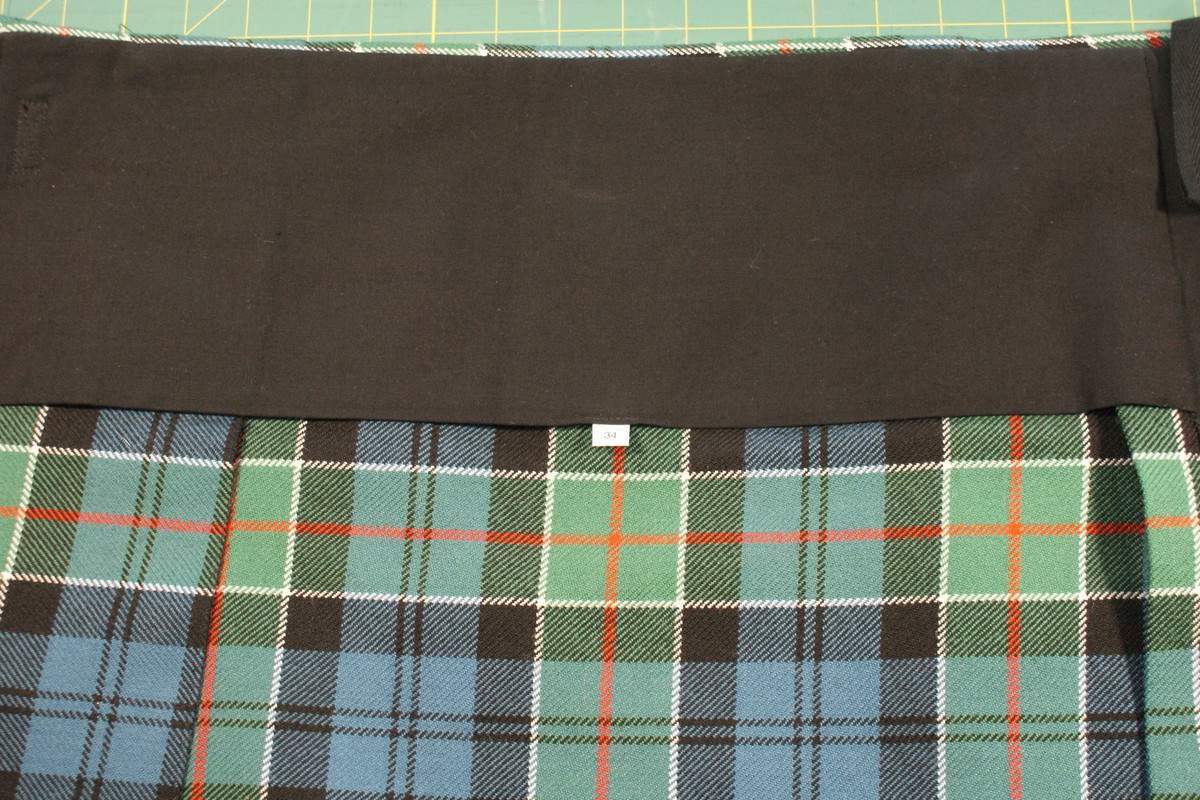
The reason that this liner is put in there is because kilts are supposed to have a liner.
But - If you lift that liner, you will find little, or perhaps even nothing, underneath.
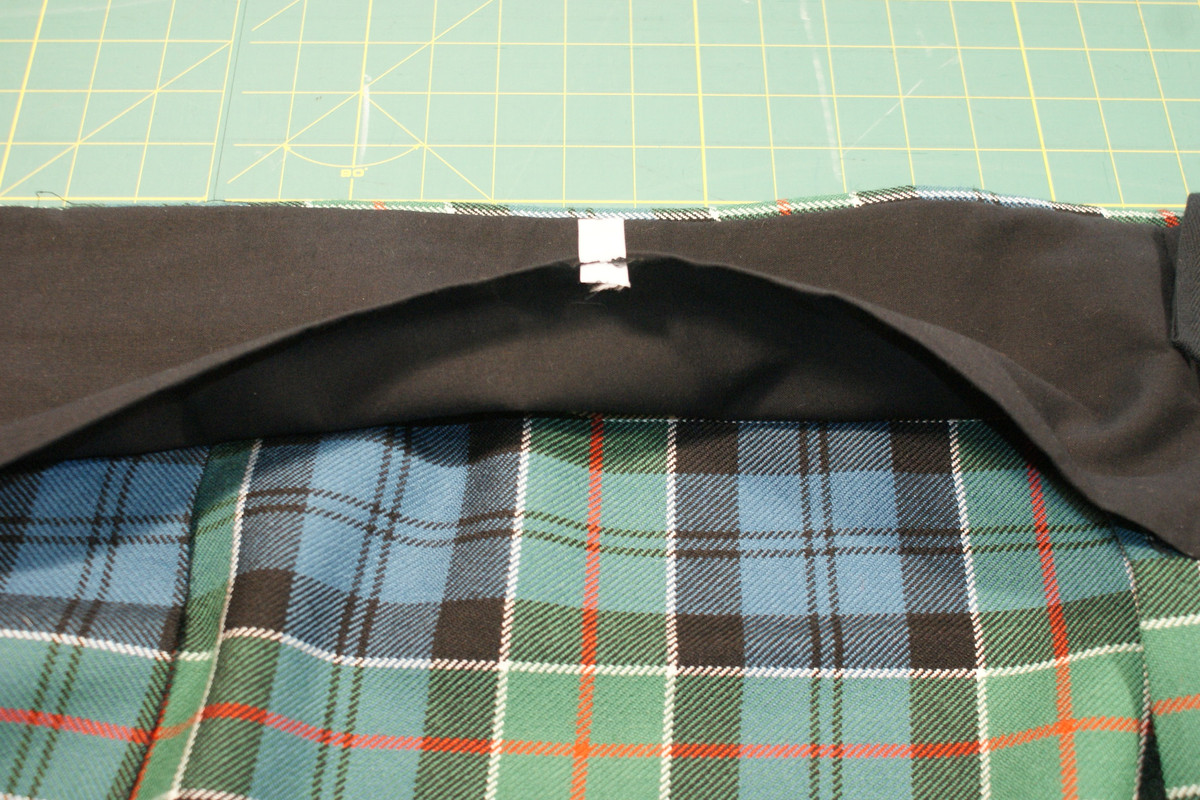
Many people, when they see this liner for the first time, assume that its purpose is to keep the kilt clean.
Well, if that were true, the liner would be removable and washable.
The actual purpose of a liner is to hide the elements built to the inside of garments that do not, or cannot, rely on just the strength of the outer fabric and the lines of stitching, for the total strength and shape of the garment.
If you were to lift the liner of the kilts in Barb and my examples - this is similar to what you would find.

Or something like this -
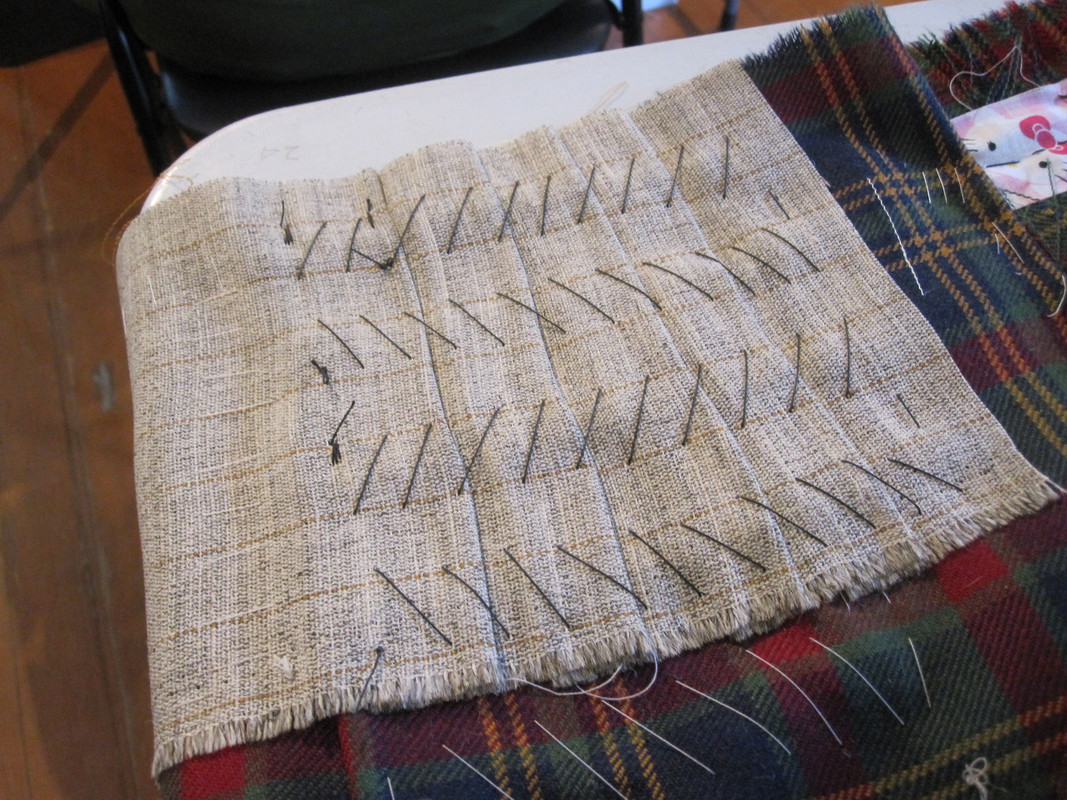
The white or cream colored stuff is called interfacing. The black strip (or in the bottom example the "hello kitty" print fabric) is called stabilizer.
If you were to turn a garment made like this inside out you would find that when you put it on, you are actually strapping on the interfacing and stabilizer. Similar to the garment having a built-in belt and corset.
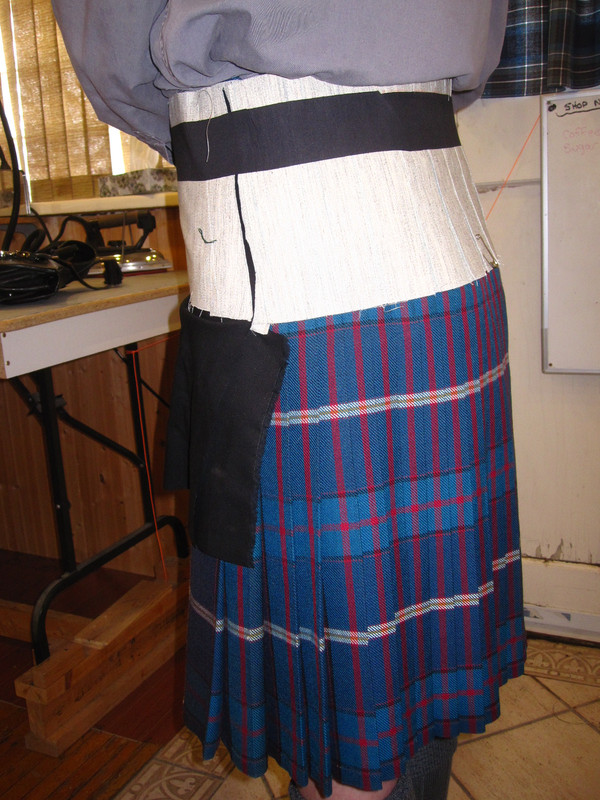
The strength, and ultimately the shape, of the garment comes from these internal elements. This allows the outer fabric to drape naturally without stress pulling on the fabric distorting it out of shape.
While some kilts made without these internal elements can, and have, been retrofitted, some cannot. And it is a daunting job for someone who is not an experienced kilt maker to try.
I would wear your kilts just the way they are. They serve you well and are perfect for their intended purpose. They are less expensive than a custom made wool kilt and may last as long as any other garment made in a similar fashion.
If you would like to research this idea of the internal elements built into a kilt may I suggest two threads which may be helpful.
The first is a kilt that seemed to stretch out of shape and change size when it was worn over a period.
http://www.xmarksthescot.com/forum/s...ad.php?t=70205
The second is a kilt that was re-built by someone who may not have known what these elements are designed to do.
http://www.xmarksthescot.com/forum/s...ad.php?t=95523
Last edited by The Wizard of BC; 3rd May 20 at 10:59 AM.
Steve Ashton
www.freedomkilts.com
Skype (webcam enabled) thewizardofbc
I wear the kilt because: Swish + Swagger = Swoon.
-
The Following 6 Users say 'Aye' to The Wizard of BC For This Useful Post:
-
Even in my rather cavalier methods of construction, the waist of my kilts have seat belt material behind them to support the weight. My back is hollow, so there is a gap over my spine where the kilt must support itself for 3 to 4 inches. The seatbelt material stands up by itself and resists deformation across its length. It is good for kilts worn with a belt.
I use narrower webbing for kilts which are held by their own straps, and more proper reinforcements - the differences are perhaps subtle, but they are done because of the different requirements of the different techniques and the stresses and strains they need to overcome.
I usually have more fabric than I need to make a kilt, so I can shuffle the pattern around if there is one, or start at one end and cut off the spare when I feel that there's enough done.
The few cheap kilts I have seen have been very skimped, one was even made from bits which had been pressed into different pleats and not smoothed out again, so you might find that improvements aren't possible because the kilt is relying on the inbuilt deformation to make up for its lack of shaping of the tailoring kind shown in these better type of kilts.
Whenever I see it laid bare I resolve to be a better tailor in future.....
Anne the Pleater
I presume to dictate to no man what he shall eat or drink or wherewithal he shall be clothed."
-- The Hon. Stuart Ruaidri Erskine, The Kilt & How to Wear It, 1901.
-
The Following 3 Users say 'Aye' to Pleater For This Useful Post:
-
I love this forum, so much information, I am learning more and more.
Thanks, guys.
-
The Following 3 Users say 'Aye' to Red1leader For This Useful Post:
-
Yes thanks for all the technical information!
All I know is that my go-to kilt, an IOS, is very comfortable, a traditional hand-sewn 16oz wool kilt, made with around 7 yards, and fairly high-waisted (25.5 inch total length). And my hose, by Cheviot, are the most comfortable hose I've ever worn.
Proud Mountaineer from the Highlands of West Virginia; son of the Revolution and Civil War; first Europeans on the Guyandotte
-
-
Last edited by OC Richard; 3rd May 20 at 05:53 PM.
Proud Mountaineer from the Highlands of West Virginia; son of the Revolution and Civil War; first Europeans on the Guyandotte
-
The Following 2 Users say 'Aye' to OC Richard For This Useful Post:
-
Yea, the problem with the low-waisted kilts, or kilts that are worn down low, is that there is little room for the sporran.
The sporran is not a crotch protector. It should not be so low as to hit you in sensitive places. The sporran is most comfortable riding up, just bouncing on the stomach. On a kilt worn at the natural waist this is not a problem as it leaves some room between the top of the kilt, or the bottom of the buckle if a belt is worn.
But most guys who wear their kilt at their jeans waist have their sporran so low that it hits and looks unsightly puckering the apron.
If you find yourself having to lift your sporran to straighten your aprons your sporran is too low.
Oh, and by-the-way, if there are two large loops on the back of the kilt, those are not belt loops. They are sporran loops and are a fairly recent addition to kilts. Probably to help the sporran stay up on guys with narrow hips or those trying to wear the kilt too low in the first place.
Putting your belt through those two loops will distort the kilt causing a "W" to form in the fabric and the shower curtain folds in the back.
If you are a 'gentleman of substance', with a belly, I strongly suggest 'sporran suspenders' which go over the belt and allow the sporran to hang straight down from the belt. The sporran chain or belt will almost always try to settle under the belly and puckers the apron something fierce.
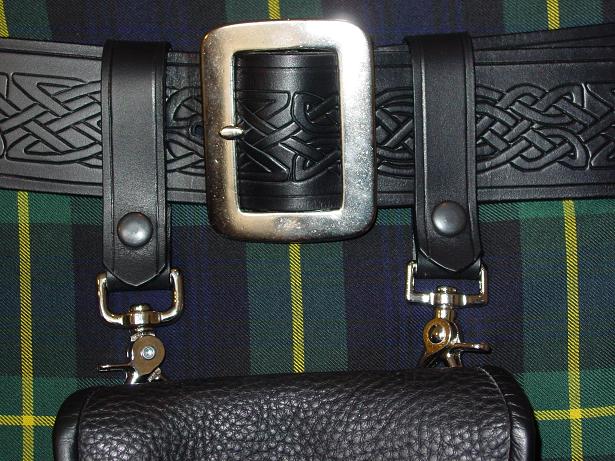
Steve Ashton
www.freedomkilts.com
Skype (webcam enabled) thewizardofbc
I wear the kilt because: Swish + Swagger = Swoon.
-
The Following User Says 'Aye' to The Wizard of BC For This Useful Post:
-
 Originally Posted by The Wizard of BC

Oh, and by-the-way, if there are two large loops on the back of the kilt, those are not belt loops. They are sporran loops and are a fairly recent addition to kilts. Probably to help the sporran stay up on guys with narrow hips or those trying to wear the kilt too low in the first place.
Talking of belt loops, I have heard tell that they should not be used and that the belt should only be used as a decorative item.
I guess if the kilt fits correctly then a belt is not required to hold up the kilt.
It is great when knowledge starts to come together to answer your own questions.
My only hope now is that the ex-hire 8-yard medium weight kilt I have ordered is not too badly built, but then for the money I am paying I guess it will not be the best 
-
-
 Originally Posted by Red1leader

Talking of belt loops, I have heard tell that they should not be used and that the belt should only be used as a decorative item.
I guess if the kilt fits correctly then a belt is not required to hold up the kilt.
This is true for some kilts. I expect it would be true for any well-made traditional kilt with a stabilizer. Even my P/V casual kilts from USA Kilts will stay up just fine without a belt, and they do not have stabilizers but rely on the lack of stretch in the P/V material. But if you've got inexpensive kilts in other materials, this might not be true. My Sport Kilts for example, while comfortable, stretch quite a bit and would not work well without a belt for some structure.
-
The Following User Says 'Aye' to MichiganKyle For This Useful Post:
-
If a kilt fits properly, it doesn't need a belt to hold it up. In fact, if you wear a Prince Charlie jacket, you don't wear a belt at all.
In terms of loops, kilts didn't use to have loops for a belt. If a kilt had loops, the loops were small and meant to hold the sporran strap. Over time, loops got bigger as people thought they ought to be able to put a belt through them. Loops have now grown to be big honking things that go half way down the fell (see second picture below) - personally, I don't find them very attractive, especially when the kilt is worn without a belt.
Although I am happy to put loops on a kilt that are big enough to hold a belt, I do try to talk people out of them for functional reasons. Here's what happens over time. Every time you sit down, the belt pulls up on the bottom of the loops, distorting the straight line of the tartan. Here's a pic (not one of my kilts) - it's a brand new kilt that has only been worn a couple of times, and the person is even standing straight up, not bending over.

Eventually, the distortion becomes permanent. If you go to Highland games and look at band kilts, you'll see this in many, many band kilts. Here's another pic that someone else posted awhile back on XMarks:

I'm a piper, and I wear my band kilt a couple times a week for gigs or competitions from May through September (in a normal year, not this year, of course), and I don't have loops on my kilt. Does the belt ride up a bit when I sit down? Sure. But it's a simple matter to push it down when I stand up.
Last edited by Barb T; 4th May 20 at 10:31 AM.
-
The Following 2 Users say 'Aye' to Barb T For This Useful Post:
-
When I make a kilt to wear with a belt rather than straps there is a waistband and the belt loops are on the band, not the pleats.
Having the luxury of making myself a new kilt whenever I feel that I would like one, I can also opt for various features as long as they are within the normal limits of being suitable for purpose.
Anne the Pleater
I presume to dictate to no man what he shall eat or drink or wherewithal he shall be clothed."
-- The Hon. Stuart Ruaidri Erskine, The Kilt & How to Wear It, 1901.
-
The Following 2 Users say 'Aye' to Pleater For This Useful Post:
 Posting Permissions
Posting Permissions
- You may not post new threads
- You may not post replies
- You may not post attachments
- You may not edit your posts
-
Forum Rules
|
|































Bookmarks